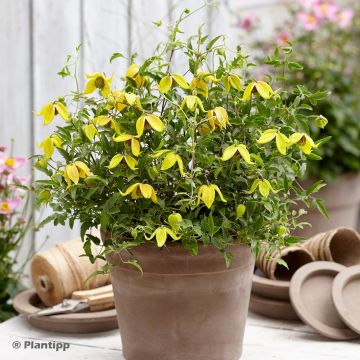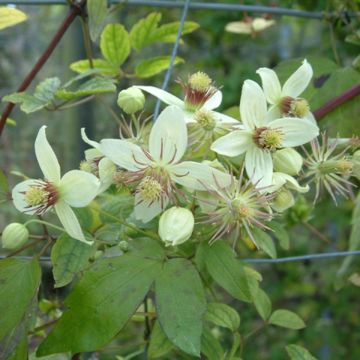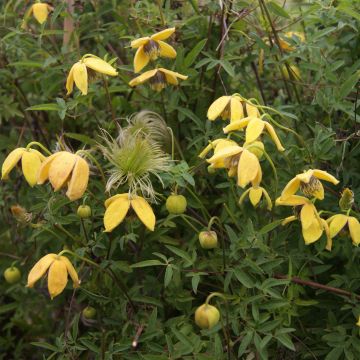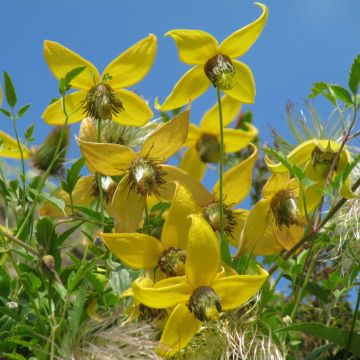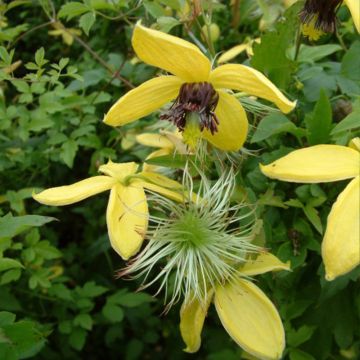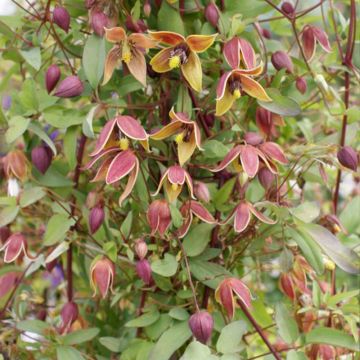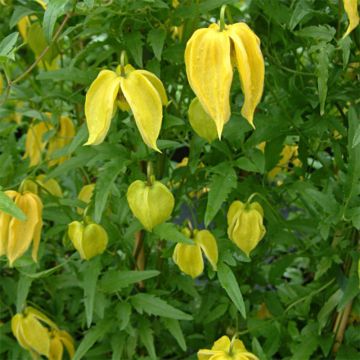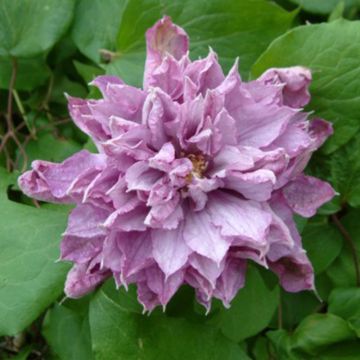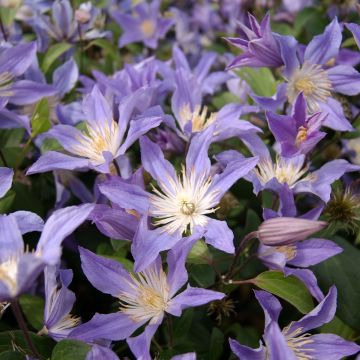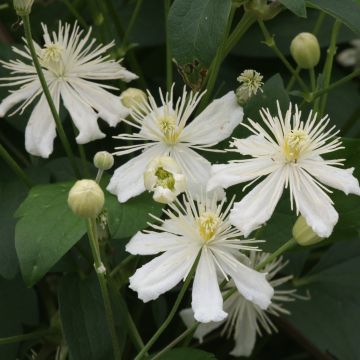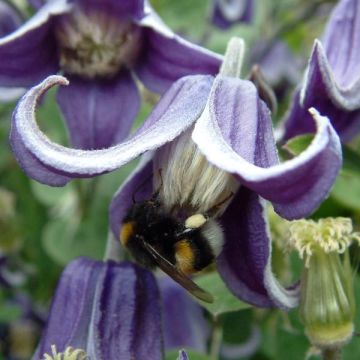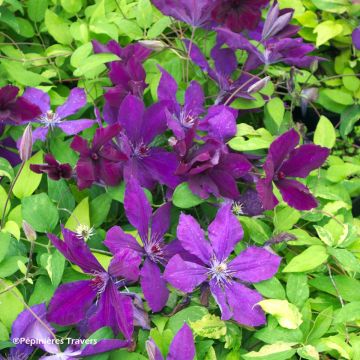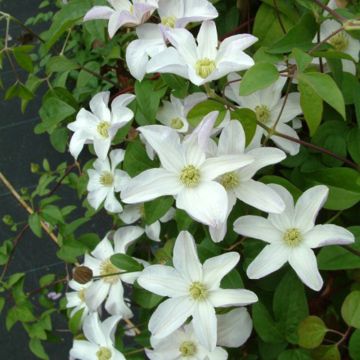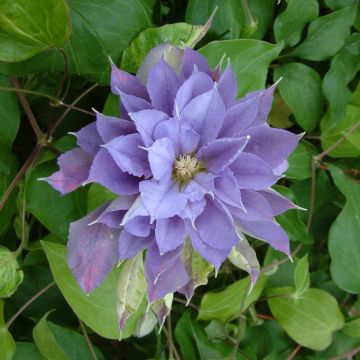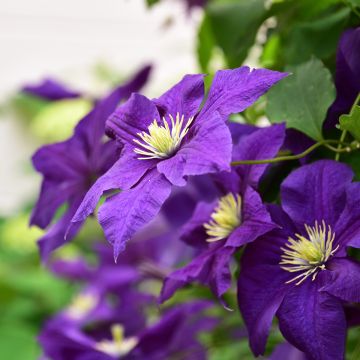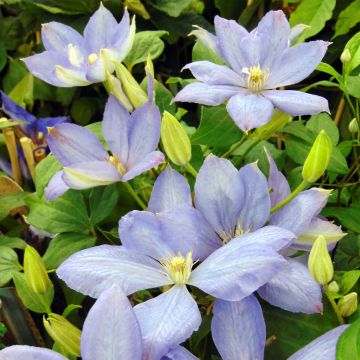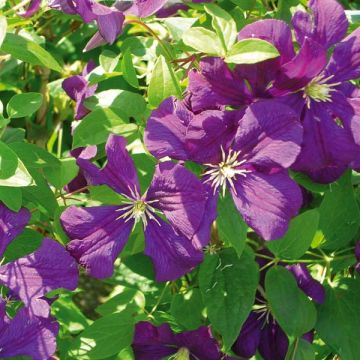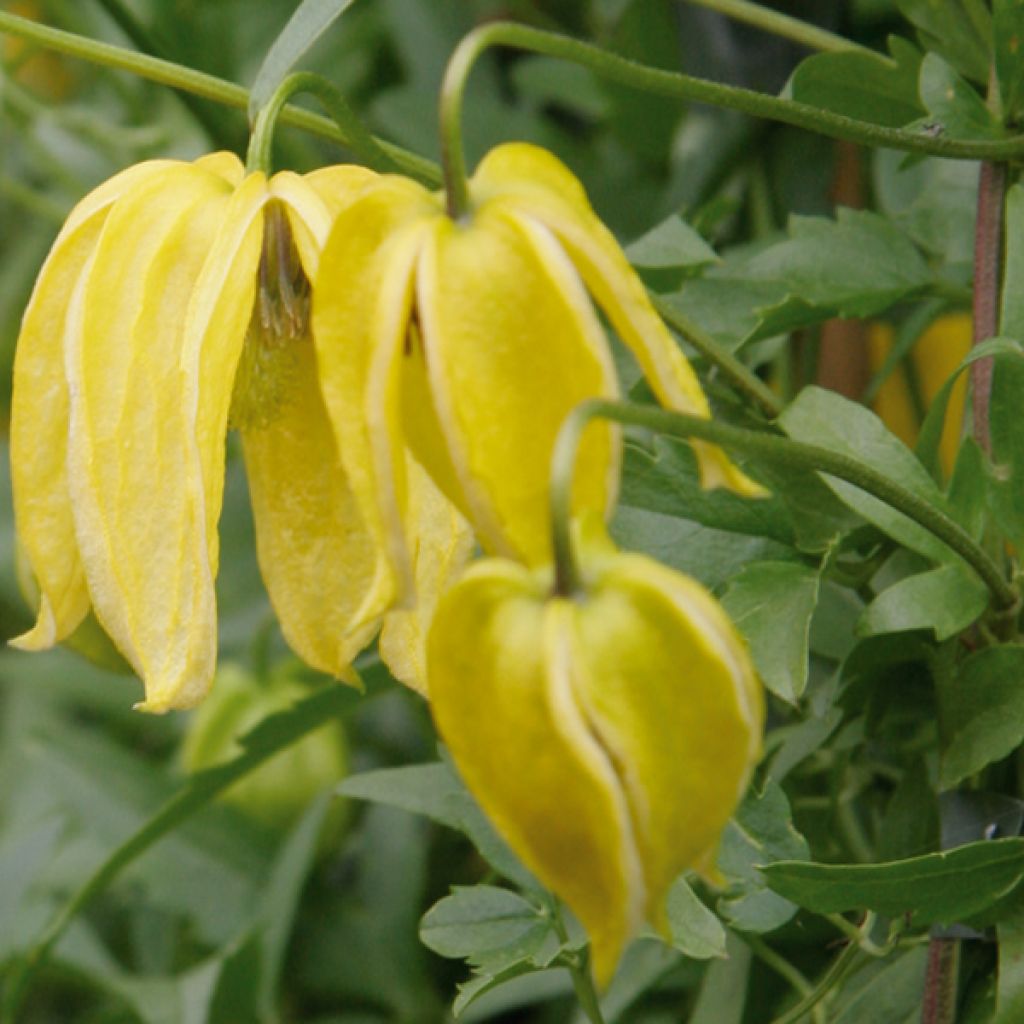

Clematis Lambton Park
Clematis Lambton Park
Clematis tangutica Lambton Park
Golden Clematis, Orange Peel Clematis, Silky Seed Heads
This item cannot be shipped to the selected country
Delivery charge from €5.90
More information
Schedule delivery date,
and select date in basket
This plant carries a 6 months recovery warranty
More information
We guarantee the quality of our plants for a full growing cycle, and will replace at our expense any plant that fails to recover under normal climatic and planting conditions.
From €5.90 for pickup delivery and €6.90 for home delivery
Express home delivery from €8.90.

Does this plant fit my garden?
Set up your Plantfit profile →
Description
Clematis 'Lambton Park' is a vigorous climbing perennial with generous and prolonged flowering. Its trailing yellow bell-shaped flowers gently open from July to September, with their tepals slightly curved at the end and emitting a light fragrance. They are followed by feathery seed heads that adorn the green foliage and scramble over various supports such as trellises, arches, and walls.
Like most Clematis, 'Lambton Park' thrives in light, deep, moist, and fertile soil. It prefers a sunny or partially shaded location, with the base of the plant always in the shade. It is hardy and can withstand freezing temperatures. However, it does not tolerate stagnant moisture, so the soil must be well-draining and you should water moderately (especially during its establishment).
From mid-summer to early autumn this Clematis, which can reach 4m (13ft) high, produces single bell-shaped, 6-7cm (2-3in) long flowers on the current year's growth. These flowers are fragrant with a scent reminiscent of coconuts, a rare quality in the genus. They consist of 4 lanceolate, beautiful bright yellow tepals, with slightly raised margins and tips. This shape and colour give them a charm that enlivens the green foliage in the background. The deciduous medium green leaves are compound, toothed, 6 to 7cm (2 to 3in) long and borne on twisting stems that twine around their support. After flowering, seed heads with a silvery grey feathery style that is airy and highly decorative appear.
The small lantern-like flowers of Clematis 'Lambton Park' reflect the summer sun and illuminate shaded parts of the garden. They pair beautifully with the blue of Salvia uliginosa, perennial Flax, and Delphiniums. Asters will also be good companions, providing shade at the base and a presence in autumn.
Report an error about the product description
Clematis Lambton Park in pictures
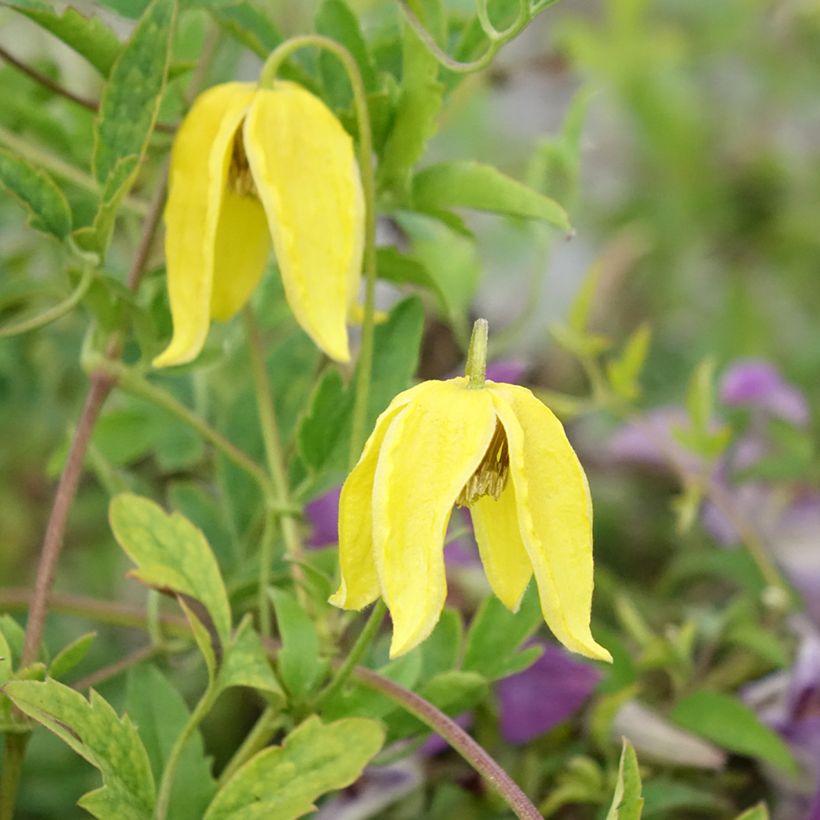

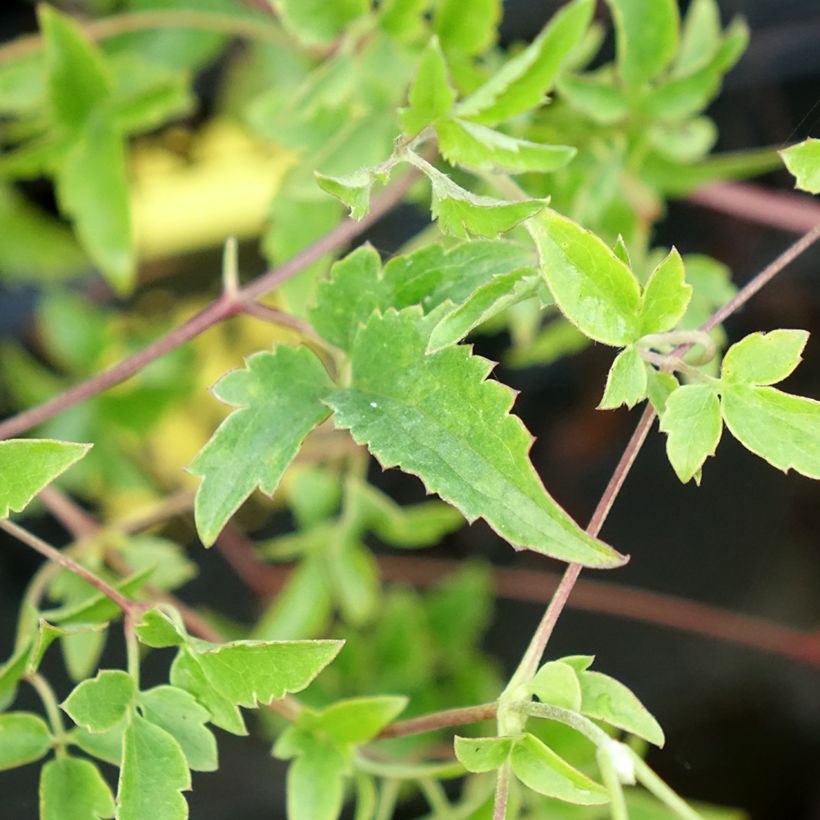

Plant habit
Flowering
Foliage
Botanical data
Clematis
tangutica
Lambton Park
Ranunculaceae
Golden Clematis, Orange Peel Clematis, Silky Seed Heads
Cultivar or hybrid
Other Clematis Tangutica
Planting and care
Clematis 'Lambton Park' should be planted in spring or autumn, 5 cm (2in) deep, with the root ball placed diagonally on the ground. The head should be in the sun (or partial shade) and the base in the shade. You can place a flat tile in front of the crpwn or plant ground cover or a perennial Geranium. It prefers soil that is rather moist but not waterlogged, deep, well-worked, and fertile. Water regularly but not excessively during the first few weeks after planting. Cover the base with a small mound of soil to encourage new shoots. After planting, prune the shoots to 30 cm (12in) from the base, above a pair of buds. Train them loosely to help the plant cling. Clematis can attach themselves using their tendrils. To promote growth, provide them with a trellis or help them dress the trunk of a tree by placing a wire mesh. Clematis also enjoy growing freely on neighbouring plants. Pruning should be done after flowering (in early winter) to shorten secondary shoots. A second pruning, in spring before growth resumes, will allow for a more severe reduction of some main stems (not necessarily every year). Always cut below a pair of buds about 30-40 cm (12-16in) from the ground. This will encourage new shoots. Watch out for pests, such as aphids and slugs and snails.
Planting period
Intended location
Care
-
, onOrder confirmed
Reply from on Promesse de fleurs
Clematis
Haven't found what you were looking for?
Hardiness is the lowest winter temperature a plant can endure without suffering serious damage or even dying. However, hardiness is affected by location (a sheltered area, such as a patio), protection (winter cover) and soil type (hardiness is improved by well-drained soil).

Photo Sharing Terms & Conditions
In order to encourage gardeners to interact and share their experiences, Promesse de fleurs offers various media enabling content to be uploaded onto its Site - in particular via the ‘Photo sharing’ module.
The User agrees to refrain from:
- Posting any content that is illegal, prejudicial, insulting, racist, inciteful to hatred, revisionist, contrary to public decency, that infringes on privacy or on the privacy rights of third parties, in particular the publicity rights of persons and goods, intellectual property rights, or the right to privacy.
- Submitting content on behalf of a third party;
- Impersonate the identity of a third party and/or publish any personal information about a third party;
In general, the User undertakes to refrain from any unethical behaviour.
All Content (in particular text, comments, files, images, photos, videos, creative works, etc.), which may be subject to property or intellectual property rights, image or other private rights, shall remain the property of the User, subject to the limited rights granted by the terms of the licence granted by Promesse de fleurs as stated below. Users are at liberty to publish or not to publish such Content on the Site, notably via the ‘Photo Sharing’ facility, and accept that this Content shall be made public and freely accessible, notably on the Internet.
Users further acknowledge, undertake to have ,and guarantee that they hold all necessary rights and permissions to publish such material on the Site, in particular with regard to the legislation in force pertaining to any privacy, property, intellectual property, image, or contractual rights, or rights of any other nature. By publishing such Content on the Site, Users acknowledge accepting full liability as publishers of the Content within the meaning of the law, and grant Promesse de fleurs, free of charge, an inclusive, worldwide licence for the said Content for the entire duration of its publication, including all reproduction, representation, up/downloading, displaying, performing, transmission, and storage rights.
Users also grant permission for their name to be linked to the Content and accept that this link may not always be made available.
By engaging in posting material, Users consent to their Content becoming automatically accessible on the Internet, in particular on other sites and/or blogs and/or web pages of the Promesse de fleurs site, including in particular social pages and the Promesse de fleurs catalogue.
Users may secure the removal of entrusted content free of charge by issuing a simple request via our contact form.
The flowering period indicated on our website applies to countries and regions located in USDA zone 8 (France, the United Kingdom, Ireland, the Netherlands, etc.)
It will vary according to where you live:
- In zones 9 to 10 (Italy, Spain, Greece, etc.), flowering will occur about 2 to 4 weeks earlier.
- In zones 6 to 7 (Germany, Poland, Slovenia, and lower mountainous regions), flowering will be delayed by 2 to 3 weeks.
- In zone 5 (Central Europe, Scandinavia), blooming will be delayed by 3 to 5 weeks.
In temperate climates, pruning of spring-flowering shrubs (forsythia, spireas, etc.) should be done just after flowering.
Pruning of summer-flowering shrubs (Indian Lilac, Perovskia, etc.) can be done in winter or spring.
In cold regions as well as with frost-sensitive plants, avoid pruning too early when severe frosts may still occur.
The planting period indicated on our website applies to countries and regions located in USDA zone 8 (France, United Kingdom, Ireland, Netherlands).
It will vary according to where you live:
- In Mediterranean zones (Marseille, Madrid, Milan, etc.), autumn and winter are the best planting periods.
- In continental zones (Strasbourg, Munich, Vienna, etc.), delay planting by 2 to 3 weeks in spring and bring it forward by 2 to 4 weeks in autumn.
- In mountainous regions (the Alps, Pyrenees, Carpathians, etc.), it is best to plant in late spring (May-June) or late summer (August-September).
The harvesting period indicated on our website applies to countries and regions in USDA zone 8 (France, England, Ireland, the Netherlands).
In colder areas (Scandinavia, Poland, Austria...) fruit and vegetable harvests are likely to be delayed by 3-4 weeks.
In warmer areas (Italy, Spain, Greece, etc.), harvesting will probably take place earlier, depending on weather conditions.
The sowing periods indicated on our website apply to countries and regions within USDA Zone 8 (France, UK, Ireland, Netherlands).
In colder areas (Scandinavia, Poland, Austria...), delay any outdoor sowing by 3-4 weeks, or sow under glass.
In warmer climes (Italy, Spain, Greece, etc.), bring outdoor sowing forward by a few weeks.

































